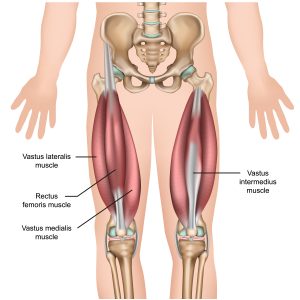Given that the quadriceps muscles are the largest muscle complex in the body, they are important to understand in depth and to focus on in training with clients. Training the quads can help to create or restore balance in the lower limbs, reduce knee pain and support daily function.
Quadriceps Muscles
The quads are often spoken about as one unit, but they are actually four individual muscles, rectus femoris, and three vastus muscles:
- Rectus Femoris: The most superficial and the only quad muscle to cross both the hip and knee joints; involved in both knee extension and hip flexion
- Vastus intermedius: Located beneath rectus femoris; the deepest of all four quadriceps muscles, making it the most challenging to stretch and massage.
- Vastus lateralis: The largest of the quad group; found laterally on the thigh. Assists in extending the knee, standing from a seated position and stabilizing the patella.
- Vastus medialis: The smallest quad muscle, positioned medially on the femur. Like all vastus muscles, it is involved in knee extension, stabilization and helps to correct patellar tracking.
While each of the quad muscles has its own function, together they work to flex the hip, extend, and stabilize the knee. They are primarily active in jumping, running, kicking, and everyday movements like walking, climbing stairs, and getting up from a seated position.
The quads’ involvement in so many movements can leave them prone to injury, making them particularly important to consider when training various clients.

Quadriceps Training Considerations
For those who are looking for aesthetic definition in their thighs, rectus femoris will be the primary focus as it is the most superficial muscle of the quad group. When targeting rectus, you’ll want to consider exercises that include both of its functions: hip flexion and knee extension.
Squats, lunges, and step-ups are all exercises that can work to strengthen rectus femoris and have various options for progression. Straight leg raises also focus on hip flexion while the knees are in extension, targeting rectus femoris by fully contracting it.
While all four quad muscles support the knee, with some considering the quads a “natural knee brace,” the vastus muscles are primary stabilizers of the knee. Strengthening the quads have proven to reduce knee pain in those with osteoarthritis and contributing to better balance and preventing the likelihood of falling.
Training the vastus muscles should include many of the same exercises as training rectus: squats, lunges, and step-ups are all beneficial. Additionally, you may try variations like Bulgarian split-squats and lateral lunges. Single-leg exercises will reinforce knee stability by placing emphasis on strengthening hip and knee stabilizers (like the vastus muscles).
The quadriceps can also be strengthened using machines commonly found in most gyms, like the leg extension machine and leg press, and with aerobic exercises like walking, running, swimming, and cycling.
Creating Balance
While strengthening the quads has many benefits, it is just as important to balance strength training with stretching and foam rolling.
The quads are vulnerable to overuse injury, strains, tears and tendinopathy so training must include adequate recovery.
Specifically, tightness in vastus lateralis has been associated with patellofemoral pain syndrome, or runner’s knee. Use of a foam roller or massage stick can help to reduce tightness in the quads.
Quad stretches can be performed standing, lying down, or kneeling. For a standing quad stretch, a wall may be used for support with balance as it will require standing on one leg. To stretch the quad standing, stand on one leg and bend into the opposite knee, grabbing ahold of the foot with your hand and pulling it toward the glute. This same stretch can be performed side lying, stretching the quad of the top leg.
Kneeling lunges also stretch both the quads and the hip flexors, which is especially beneficial after training rectus and performing exercises involving hip flexion.
As with all muscles, the quads do not work alone. In addition to supporting each other, the quads are also supported by the hamstrings, with which they work antagonistically, and the glutes. So, part of creating balance and preventing injury in the quads is also strengthening and stretching the glutes and hamstrings.
While all muscles in the body are important to understand as trainers, the largest and strongest muscle group in the body may demand some extra attention.
References
https://health.clevelandclinic.org/how-to-strengthen-your-quads-to-potentially-reduce-your-risk-of-knee-osteoarthritis/
https://www.medicalnewstoday.com/articles/quadriceps-muscles#summary
https://www.physio-pedia.com/Quadriceps_Muscle

